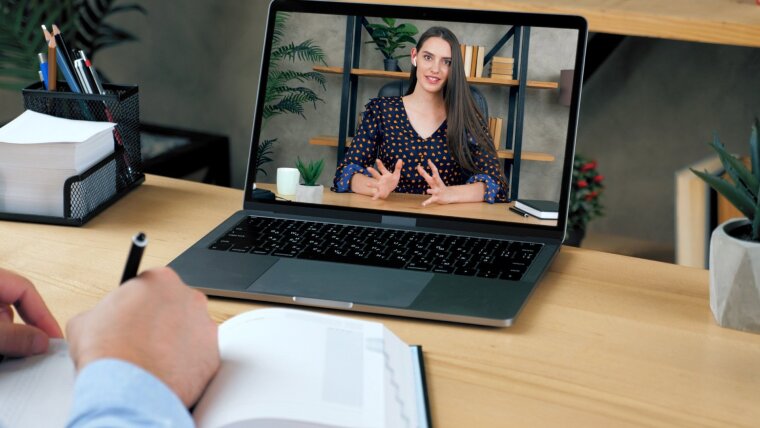
The examination format of an electronic exam under online supervision via Zoom, which was widely used during the Corona pandemic, is no longer recommended due to increased susceptibility to cheating, e.g. through the use of generative AI and limited supervision options.
Advantages of oral online exams
This has the following decisive advantages, among others:
- Accessibility for some people with physical disabilities
- Saves time, as there is no need to go to the university
- familiar surroundings can mean less stress in the exam situation
- Students who are currently abroad (e.g. due to internships or semesters abroad) can be examined.
Legal aspects
In contrast to online courses via video conferencing system, where the processing of audio and video data of students is only based on voluntary and revocable consent, other data protection regulations /(in German) de apply to written and oral online examinations with video conferencing system according to the 2nd amendment of the Corona Framework Statutespdf, 347 kb · de (dated May 5, 2021; in German). Here, data processing is carried out on a legal basis (Section 3 (9) of the Corona Framework Statutes), i.e. data processing is lawful if and to the extent that it is necessary to fulfill the task of the University of Jena to take examinations. The necessity arises from the fact that acts of deception (e.g. through the help of third parties) are to be avoided and, as a result, equal examination conditions are created for all examination participants in order to ensure the examination under equal conditions;
Recording an oral examination conducted by video conference is not permitted.
Before the examination
-
Informing students about the examination format and conditions
As the video examination involves technical and organizational effort, candidates should be informed at least 14 days in advance of the individually scheduled examination date and the examination modalities, in particular the online mode. They should also clarify the technical and organizational requirements when making the appointment. Together with the invitation to the video conference meeting, you should also send out the data protection information for online examinations (in German) de.
Also refer your examinees to the information pages for students (in German) de .
-
Setting up a video conference
Only the service provided by the University of Jena, which has been preset according to data protection and data security criteria as well as performance and user-friendliness requirements, may be used for video supervision. The University of Jena has procured the video conferencing software ZoomExternal link; and secured it with considerable security settings. Further information can be found on the website of the Multimedia Center.
The Zoom video conferencing software offers the following options for setting up the online oral examination:
- Virtual waiting room: you should control access to the examination room via the virtual waiting room if you are taking several examinations in succession. After the examination, the examinee can be sent back to the waiting room while the examiners are consulting.
- Note on the VPN connection: Please note that video conferences should not be conducted via the VPN connection. This improves the quality of the video conference and saves bandwidth for other services, e.g. Moodle.
-
Clarifying technical requirements
To avoid (technical) problems, point out the following points to your candidates in advance:
- A stable Internet connection is a basic requirement.
- Only current browsers should be used.
- Video conferences should not be held via the VPN connection. This improves the quality of the video conference.
- The examinees must have a functioning webcam and microphone for the examination. If the examinee does not have a webcam, students can borrow the webcam required for the examinations from the Multimedia CentreExternal link. In principle, a smartphone in combination with a headset is also sufficient.
- Advise your students to carry out a technical test in advance to test the setup of the zoom, webcam and microphone and to identify and resolve any technical problems in advance.
Point out the information pages on digital examinations for students (in German) de . There you will find the following information, among others:
- Avoidance of disruptive factors that can be ruled out in advance.
- How to set up the camera correctly.
- How to create a safe exam environment.
-
Clarifying organizational requirements
Point out to the examinees that they must ensure that a room is used for the examination in which the examinees are alone as part of the preparations for the examination. They must ensure that no disturbances occur during the examination. Both can be checked by means of a room scan in case of suspicion.
During the examination
-
Identity check
If the candidate for an oral examination is not personally known to at least one examiner, an identity check must be carried out to ensure that the correct person is taking the examination. For this purpose, the examinee may be required to show their Thoska, identity card or comparable official identity document with the help of the camera.
-
Instruction of the examinee
In order to avoid problems and discrepancies on the day of the exam and to be able to respond to questions, you should inform the examinees of all (technical) requirements and rules as early as possible. This creates security for both you and the students. Students must be informed of their rights and obligations before the examination at the latest. Inform the examinees about the following points in the instructions:
- With the instruction, the students also confirm that they have taken note of the data protection information for online examinations (in German) de. Provide the data protection information for digital examinations at least 14 days before the examination.
- How you will deal with attempts to cheat.
- How to deal with technical faults during the examination.
-
Creating a safe examination environment
The assistance of other persons is excluded. Students must be alone in the room. However, a so-called room scan should not be carried out inappropriately and therefore across the board, as this is seen as an intrusion into the student's private sphere (most students are in their private rooms for the examination). We therefore recommend only using this method if the examinee is behaving suspiciously. If there is another person in the room, whispering may be audible, the examinee may not react ad hoc to the questions and may look around conspicuously.
If necessary, have the examinee set up their camera so that the closed room door is visible behind them.
-
Dealing with attempted deception
If the behavior of the examinee described above gives you the impression of an attempt to cheat, you can ask the examinee to pan the camera around the room or, if there are reasonable and documentable indications, have the screen content displayed. In the event of suspected cheating, the student must always be given a hearing afterwards in which the suspicion is presented to him or her. Only after the hearing can the cheating be determined or not determined. If cheating can be detected, e.g. because another person is in the room, the examination will be aborted and graded 5.0 after the student has been heard. If the cheating cannot be clearly detected during the examination, the examination should be continued with reservations.
If cheating is detected with a result of 5.0, a second examination should be taken in presence.
-
Dealing with technical faults during the test
If students have an unstable internet connection or other technical problems, you as the examiner cannot actively help. Instead, the decisive factor is how you deal with this situation. Reassure the examinee and consider remedying or compensating for the disruption, for example by extending the exam.
If the exam is disrupted several times by technical problems, the exam should be aborted and repeated in person. Participation in the examination will not be assessed and will not be counted as an examination attempt. However, this only applies to technical problems that are not the responsibility of the student concerned (e.g. by disregarding the instructions given in advance, such as using the latest browser, etc.) and if this disruption cannot be rectified during the examination or compensated for - e.g. by extending the examination.
Analogous to the general course of the examination, the technical course of the examination should also be appropriately noted. Faults must be recorded according to their type, extent and duration, as well as the implementation of fault compensation measures.
